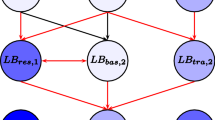Abstract
The paper proposes a new exact approach, based on a Branch, Bound, and Remember (BB&R) algorithm that uses the Cyclic Best First Search (CBFS) strategy, for the 1|r i |∑U i scheduling problem, a single machine scheduling problem, where the objective is to find a schedule with the minimum number of tardy jobs. The search space is reduced using new and improved dominance properties and tighter upper bounds, based on a new dynamic programming algorithm. Computational results establish the effectiveness of the BB&R algorithm with CBFS for a broad spectrum of problem instances. In particular, this algorithm was able to solve all problems instances, up to 300 jobs, while existing best known algorithms only solve problems instances up to 200 jobs. Furthermore, the BB&R algorithm with CBFS runs one to two orders of magnitude faster than the current best known algorithm on comparable instances.
Similar content being viewed by others
References
Baptiste, P., Le Pape, C., Peridy, L.: Global constraints for partial CSPs: a case-study of resource and due date constraints. In: Constraint Programming 98. Lecture Notes in Computer Science, vol. 1520, pp. 87–101 (1998)
Baptiste, P., Peridy, L., Pinson, E.: A branch and bound to minimize the number of late jobs on a single machine with release time constraints. Eur. J. Oper. Res. 144(1), 1–11 (2003)
Bedworth, D., Bailey, J.: Integrated Production Control Systems: Management, Analysis, Design. Wiley, New York (1987)
Bellman, R.: Dynamic Programming. Princeton University Press, Princeton (1957)
Brucker, P.: Scheduling Algorithms, 2nd edn. Springer, Heidelberg (2007)
Dauzère-Pérès, S.: Minimizing late jobs in the general one machine scheduling problem. Eur. J. Oper. Res. 81(1), 134–142 (1995)
Dauzère-Pérès, S., Sevaux, M.: Using Lagrangean relaxation to minimize the weighted number of late jobs on a single machine. Nav. Res. Logist. 50(3), 273–288 (2003)
Dauzère-Pérès, S., Sevaux, M.: An exact method to minimize the number of tardy jobs in single machine scheduling. J. Sched. 7(6), 405–420 (2004)
Glover, F.: Future paths for integer programming and links to artificial intelligence. Comput. Oper. Res. 13(5), 533–549 (1986)
Graham, R., Lawler, E., Lenstra, J.K., Rinnooy Kan, A.: Optimization and approximation in deterministic sequencing and scheduling: a survey. Ann. Discrete Math. 4, 287–326 (1979)
Jouglet, A., Baptiste, P., Carlier, J.: Branch-and-bound algorithms for total weighted tardiness. In: Leung, J.Y.-T. (ed.) Handbook of Scheduling: Algorithms, Models, and Performance Analysis. CRC Press, Boca Raton (2004)
Kao, G.K., Sewell, E.C., Jacobson, S.H.: A Branch, Bound, and remember algorithm for the 1|r i |∑t i scheduling problem. J. Sched. 12(2), 163–175 (2009)
Kise, H., Ibaraki, T., Mine, H.: A solvable case of the one-machine scheduling problem with ready and due times. Oper. Res. 26(1), 121–126 (1978)
Koulamas, C.: The total tardiness problem: review and extensions. Oper. Res. 42(6), 1025–1041 (1994)
Lasserre, J., Queyranne, M.: Generic scheduling polyhedra and a new mixed integer formulation for single machine scheduling. In: Proceedings of the 2nd Integer Programming Conference, Pittsburgh, PA, pp. 136–149 (1992)
Lawler, E.: Knapsack-like scheduling problems, the Moore-Hodgson algorithm and the “tower of sets” property. Math. Comput. Model. 20(2), 91–106 (1994)
Lenstra, J.K., Rinnooy Kan, A., Brucker, P.: Complexity of machine scheduling problems. Ann. Discrete Math. 1, 342–362 (1977)
M’Hallah, R., Bulfin, R.L.: Minimizing the weighted number of tardy jobs on a single machine with release dates. Eur. J. Oper. Res. 176(2), 727–744 (2007)
Moore, J.M.: An n job, one machine sequencing algorithm for minimizing the number of late jobs. Manag. Sci. 15(1), 102–109 (1968)
Morin, T., Marsten, R.: Branch-and-bound strategies for dynamic programming. Oper. Res. 24(4), 611–627 (1976)
Nemhauser, G.: Introduction to Dynamic Programming. Wiley, New York (1966)
Péridy, L., Pinson, E., Rivreau, D.: Using short-term memory to minimize the weighted number of late jobs on a single machine. Eur. J. Oper. Res. 148(3), 591–603 (2003)
Pinedo, M.L.: Planning and Scheduling in Manufacturing and Services. Springer, Heidelberg (2005)
Potts, C.N., Van Wassenhove, L.N.: A branch and bound algorithm for the total weighted tardiness problem. Oper. Res. 33, 363–377 (1985)
Rinnooy Kan, A.: Machine Scheduling Problem: Classification, Complexity and Computations. Nijhoff, Hague (1976)
Sadykov, R.: A Hybrid Branch and Cut for the One Dimensional Machine Scheduling Problem. Lecture Notes in Computer Science, vol. 3011, pp. 409–414 (2004)
Sellers, D.W.: A survey of approaches to the job shop scheduling problem. In: 28th Southeastern Symposium on System Theory, Baton Rouge, LA, pp. 396–400 (1996)
Sevaux, M., Dauzère-Pérès, S.: Genetic algorithms to minimize the weighted number of late jobs on a single machine. Eur. J. Oper. Res. 151(2), 296–306 (2000)
Sewell, E.C., Kao, G.K., Jacobson, S.H.: Minimizing total tardiness for the single machine with sequence dependent setup time problem using the BB&R algorithm. Technical Report, University of Illinois, Urbana, Illinois
Zhou, R., Hansen, E.A.: Structured duplicate detection in external-memory graph search. In: Proc. of 19th National Conference on Artificial Intelligence, San Jose, CA, pp. 683–689 (2004)
Zhou, R., Hansen, E.A.: Beam-stack search: integrating backtracking with beam search. In: Proc. of 15th International Conference on Automated Planning and Scheduling, Pittsburgh, PA, pp. 90–98 (2005)
Author information
Authors and Affiliations
Corresponding author
Rights and permissions
About this article
Cite this article
Kao, G.K., Sewell, E.C., Jacobson, S.H. et al. New dominance rules and exploration strategies for the 1|r i |∑U i scheduling problem. Comput Optim Appl 51, 1253–1274 (2012). https://doi.org/10.1007/s10589-010-9378-7
Received:
Published:
Issue Date:
DOI: https://doi.org/10.1007/s10589-010-9378-7




